Impact of Schedule Delays and Cost Overrun on Construction Projects
VerifiedAdded on 2023/01/19
|60
|19640
|1
Project
AI Summary
This project analyzes the effects of schedule delays and cost overruns on construction projects, aiming to understand their interrelationship and impact. The research employs both quantitative and qualitative data collection methods, including a survey of 20 contractors, and utilizes SPSS for statistical analysis to determine the correlation between schedule delays and cost overruns. The study reviews existing literature to provide context, and the findings highlight factors contributing to schedule delays such as labor strikes, resource limitations, poor management, and planning errors. The project concludes with recommendations for minimizing the impact of delays and cost overruns, suggesting techniques for activity management and improved labor performance. The research also assesses the reliability of the findings for future use by researchers and practitioners.
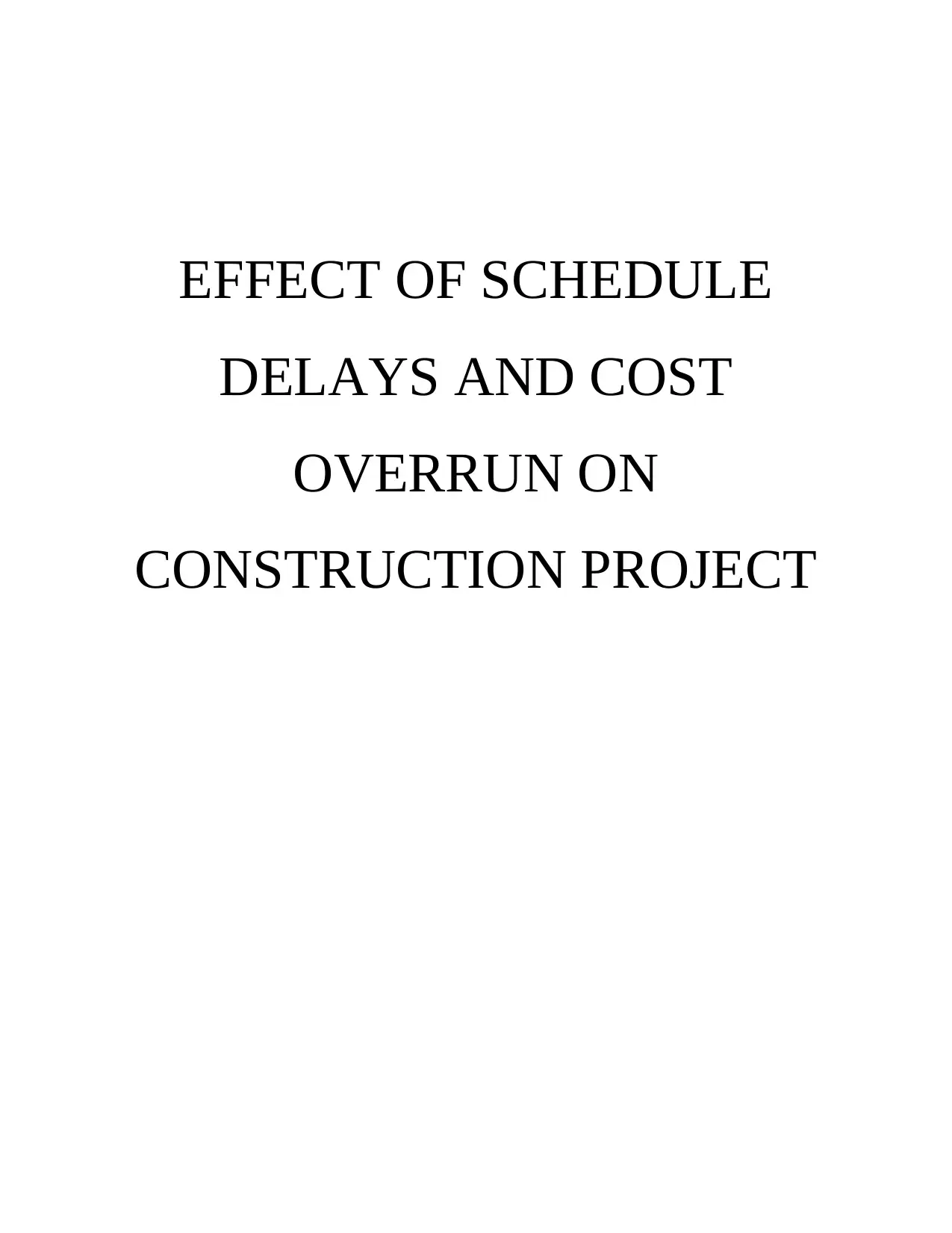
EFFECT OF SCHEDULE
DELAYS AND COST
OVERRUN ON
CONSTRUCTION PROJECT
DELAYS AND COST
OVERRUN ON
CONSTRUCTION PROJECT
Paraphrase This Document
Need a fresh take? Get an instant paraphrase of this document with our AI Paraphraser
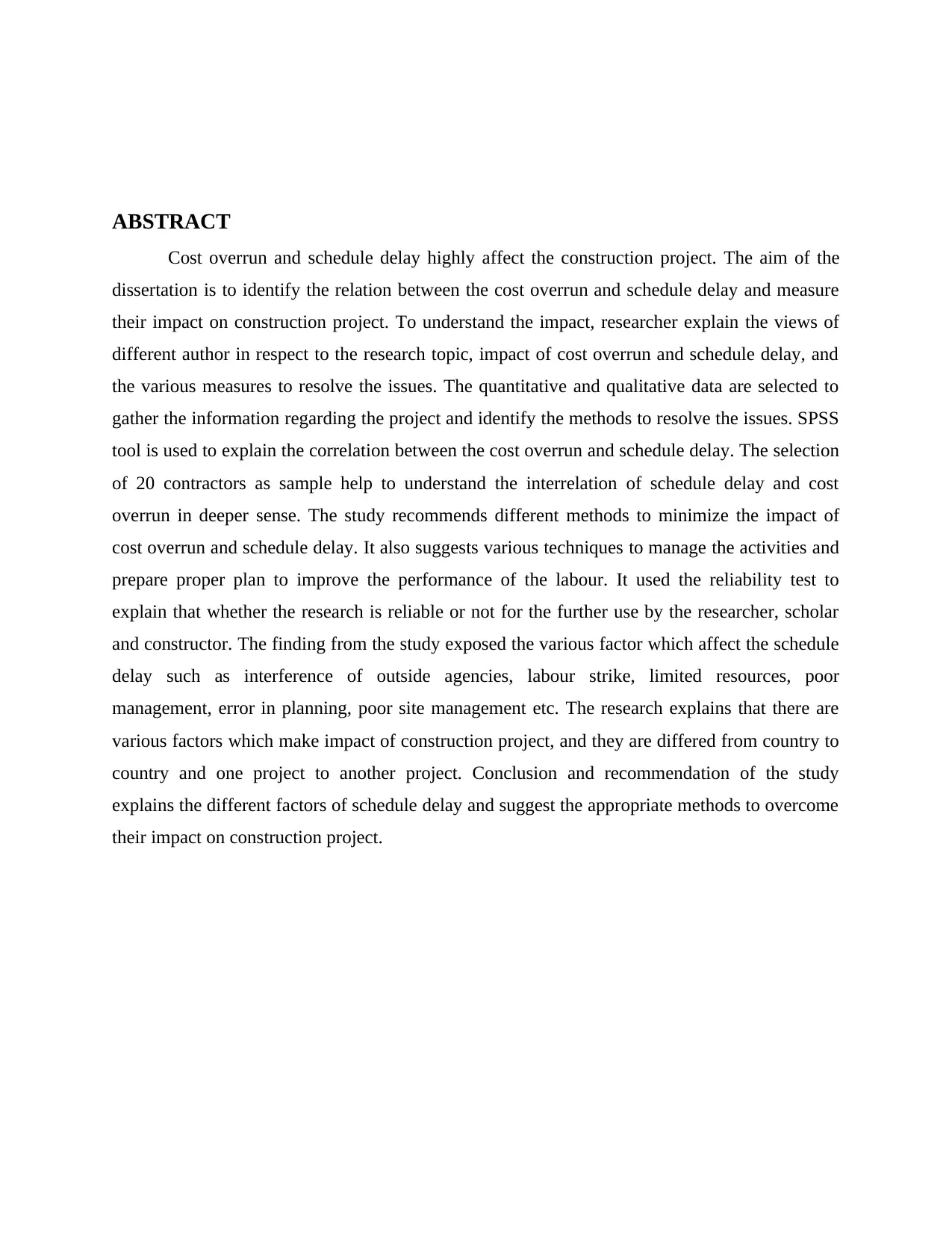
ABSTRACT
Cost overrun and schedule delay highly affect the construction project. The aim of the
dissertation is to identify the relation between the cost overrun and schedule delay and measure
their impact on construction project. To understand the impact, researcher explain the views of
different author in respect to the research topic, impact of cost overrun and schedule delay, and
the various measures to resolve the issues. The quantitative and qualitative data are selected to
gather the information regarding the project and identify the methods to resolve the issues. SPSS
tool is used to explain the correlation between the cost overrun and schedule delay. The selection
of 20 contractors as sample help to understand the interrelation of schedule delay and cost
overrun in deeper sense. The study recommends different methods to minimize the impact of
cost overrun and schedule delay. It also suggests various techniques to manage the activities and
prepare proper plan to improve the performance of the labour. It used the reliability test to
explain that whether the research is reliable or not for the further use by the researcher, scholar
and constructor. The finding from the study exposed the various factor which affect the schedule
delay such as interference of outside agencies, labour strike, limited resources, poor
management, error in planning, poor site management etc. The research explains that there are
various factors which make impact of construction project, and they are differed from country to
country and one project to another project. Conclusion and recommendation of the study
explains the different factors of schedule delay and suggest the appropriate methods to overcome
their impact on construction project.
Cost overrun and schedule delay highly affect the construction project. The aim of the
dissertation is to identify the relation between the cost overrun and schedule delay and measure
their impact on construction project. To understand the impact, researcher explain the views of
different author in respect to the research topic, impact of cost overrun and schedule delay, and
the various measures to resolve the issues. The quantitative and qualitative data are selected to
gather the information regarding the project and identify the methods to resolve the issues. SPSS
tool is used to explain the correlation between the cost overrun and schedule delay. The selection
of 20 contractors as sample help to understand the interrelation of schedule delay and cost
overrun in deeper sense. The study recommends different methods to minimize the impact of
cost overrun and schedule delay. It also suggests various techniques to manage the activities and
prepare proper plan to improve the performance of the labour. It used the reliability test to
explain that whether the research is reliable or not for the further use by the researcher, scholar
and constructor. The finding from the study exposed the various factor which affect the schedule
delay such as interference of outside agencies, labour strike, limited resources, poor
management, error in planning, poor site management etc. The research explains that there are
various factors which make impact of construction project, and they are differed from country to
country and one project to another project. Conclusion and recommendation of the study
explains the different factors of schedule delay and suggest the appropriate methods to overcome
their impact on construction project.
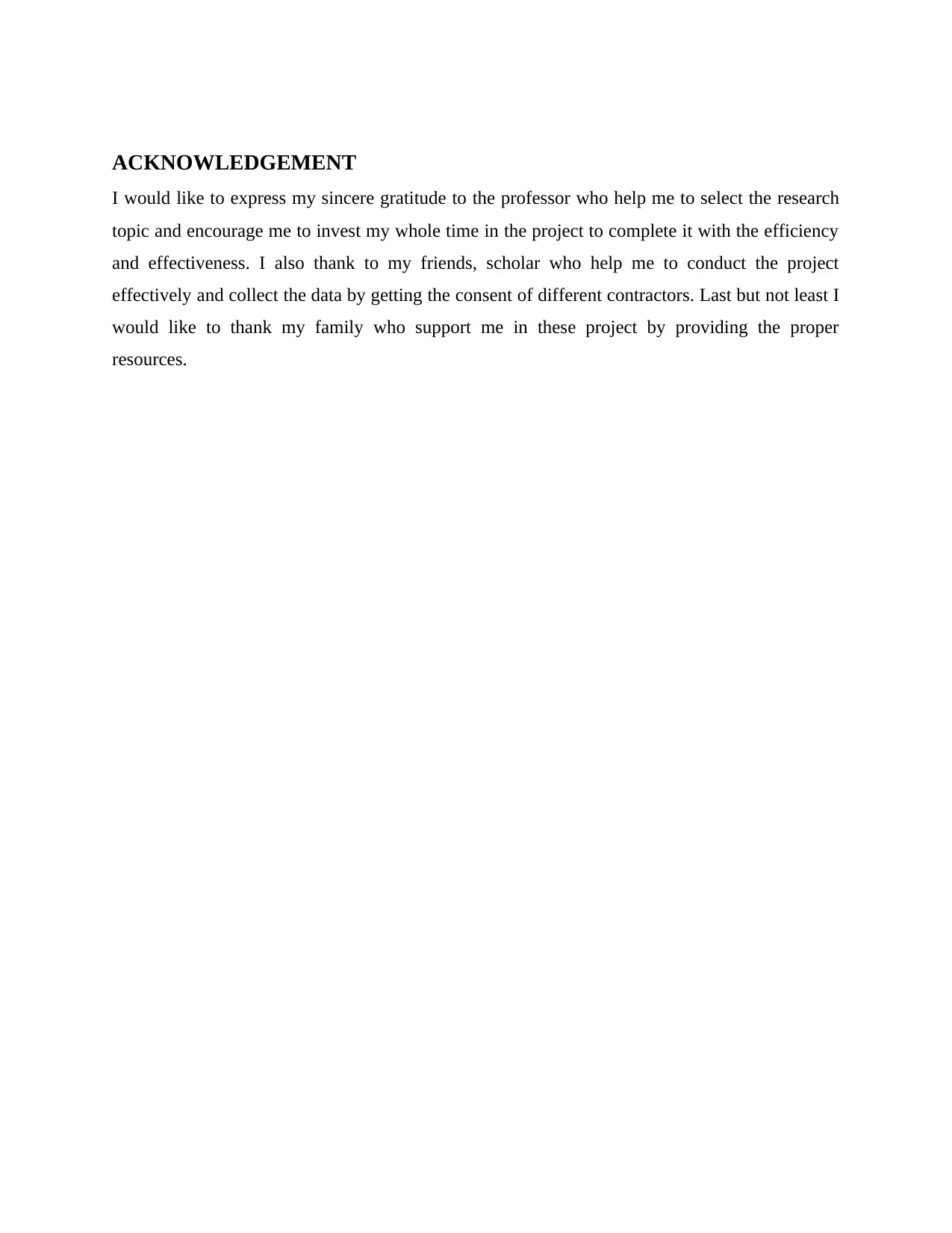
ACKNOWLEDGEMENT
I would like to express my sincere gratitude to the professor who help me to select the research
topic and encourage me to invest my whole time in the project to complete it with the efficiency
and effectiveness. I also thank to my friends, scholar who help me to conduct the project
effectively and collect the data by getting the consent of different contractors. Last but not least I
would like to thank my family who support me in these project by providing the proper
resources.
I would like to express my sincere gratitude to the professor who help me to select the research
topic and encourage me to invest my whole time in the project to complete it with the efficiency
and effectiveness. I also thank to my friends, scholar who help me to conduct the project
effectively and collect the data by getting the consent of different contractors. Last but not least I
would like to thank my family who support me in these project by providing the proper
resources.
⊘ This is a preview!⊘
Do you want full access?
Subscribe today to unlock all pages.

Trusted by 1+ million students worldwide
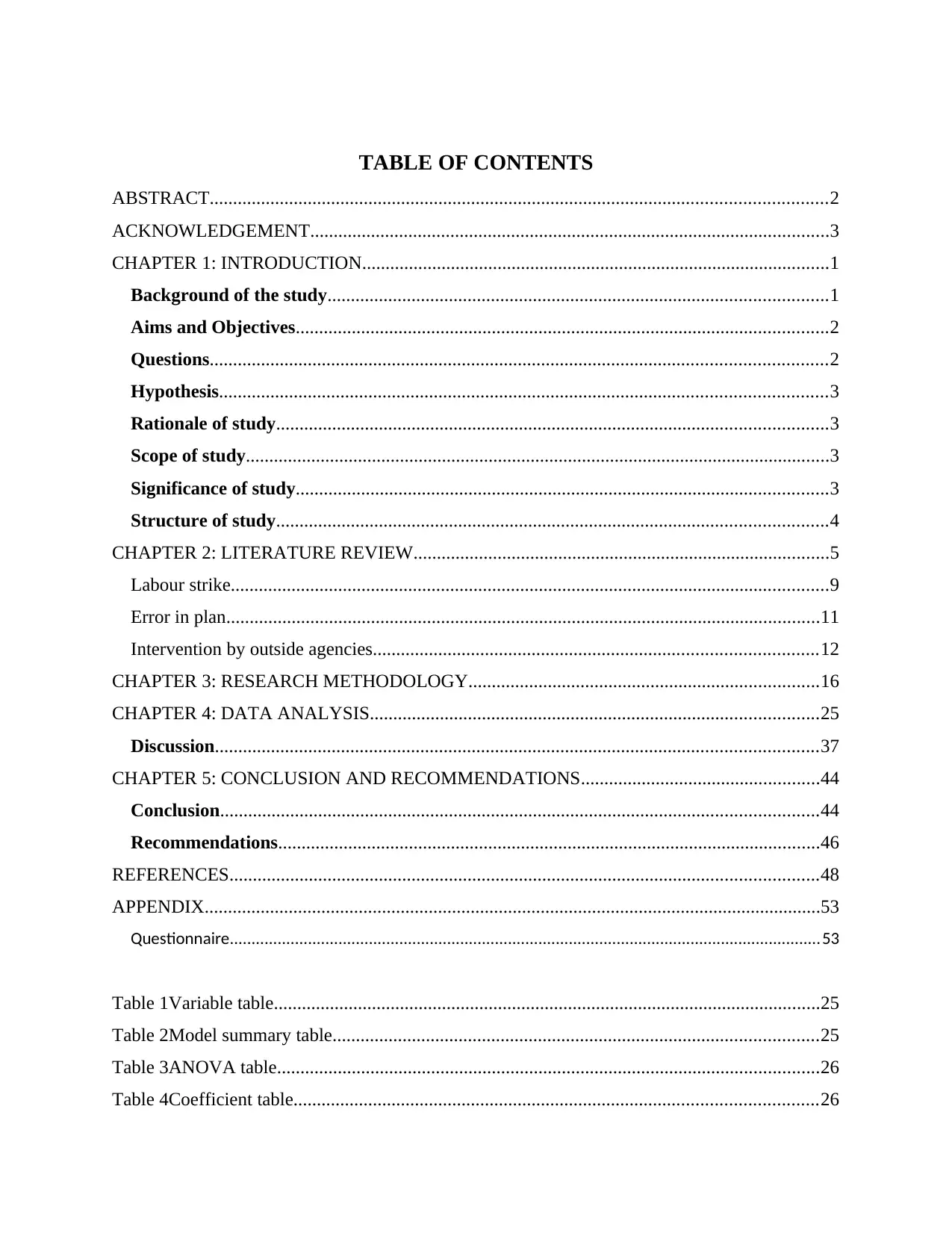
TABLE OF CONTENTS
ABSTRACT....................................................................................................................................2
ACKNOWLEDGEMENT...............................................................................................................3
CHAPTER 1: INTRODUCTION....................................................................................................1
Background of the study...........................................................................................................1
Aims and Objectives..................................................................................................................2
Questions....................................................................................................................................2
Hypothesis..................................................................................................................................3
Rationale of study......................................................................................................................3
Scope of study.............................................................................................................................3
Significance of study..................................................................................................................3
Structure of study......................................................................................................................4
CHAPTER 2: LITERATURE REVIEW.........................................................................................5
Labour strike................................................................................................................................9
Error in plan...............................................................................................................................11
Intervention by outside agencies...............................................................................................12
CHAPTER 3: RESEARCH METHODOLOGY...........................................................................16
CHAPTER 4: DATA ANALYSIS................................................................................................25
Discussion.................................................................................................................................37
CHAPTER 5: CONCLUSION AND RECOMMENDATIONS...................................................44
Conclusion................................................................................................................................44
Recommendations....................................................................................................................46
REFERENCES..............................................................................................................................48
APPENDIX....................................................................................................................................53
Questionnaire........................................................................................................................................53
Table 1Variable table.....................................................................................................................25
Table 2Model summary table........................................................................................................25
Table 3ANOVA table....................................................................................................................26
Table 4Coefficient table................................................................................................................26
ABSTRACT....................................................................................................................................2
ACKNOWLEDGEMENT...............................................................................................................3
CHAPTER 1: INTRODUCTION....................................................................................................1
Background of the study...........................................................................................................1
Aims and Objectives..................................................................................................................2
Questions....................................................................................................................................2
Hypothesis..................................................................................................................................3
Rationale of study......................................................................................................................3
Scope of study.............................................................................................................................3
Significance of study..................................................................................................................3
Structure of study......................................................................................................................4
CHAPTER 2: LITERATURE REVIEW.........................................................................................5
Labour strike................................................................................................................................9
Error in plan...............................................................................................................................11
Intervention by outside agencies...............................................................................................12
CHAPTER 3: RESEARCH METHODOLOGY...........................................................................16
CHAPTER 4: DATA ANALYSIS................................................................................................25
Discussion.................................................................................................................................37
CHAPTER 5: CONCLUSION AND RECOMMENDATIONS...................................................44
Conclusion................................................................................................................................44
Recommendations....................................................................................................................46
REFERENCES..............................................................................................................................48
APPENDIX....................................................................................................................................53
Questionnaire........................................................................................................................................53
Table 1Variable table.....................................................................................................................25
Table 2Model summary table........................................................................................................25
Table 3ANOVA table....................................................................................................................26
Table 4Coefficient table................................................................................................................26
Paraphrase This Document
Need a fresh take? Get an instant paraphrase of this document with our AI Paraphraser
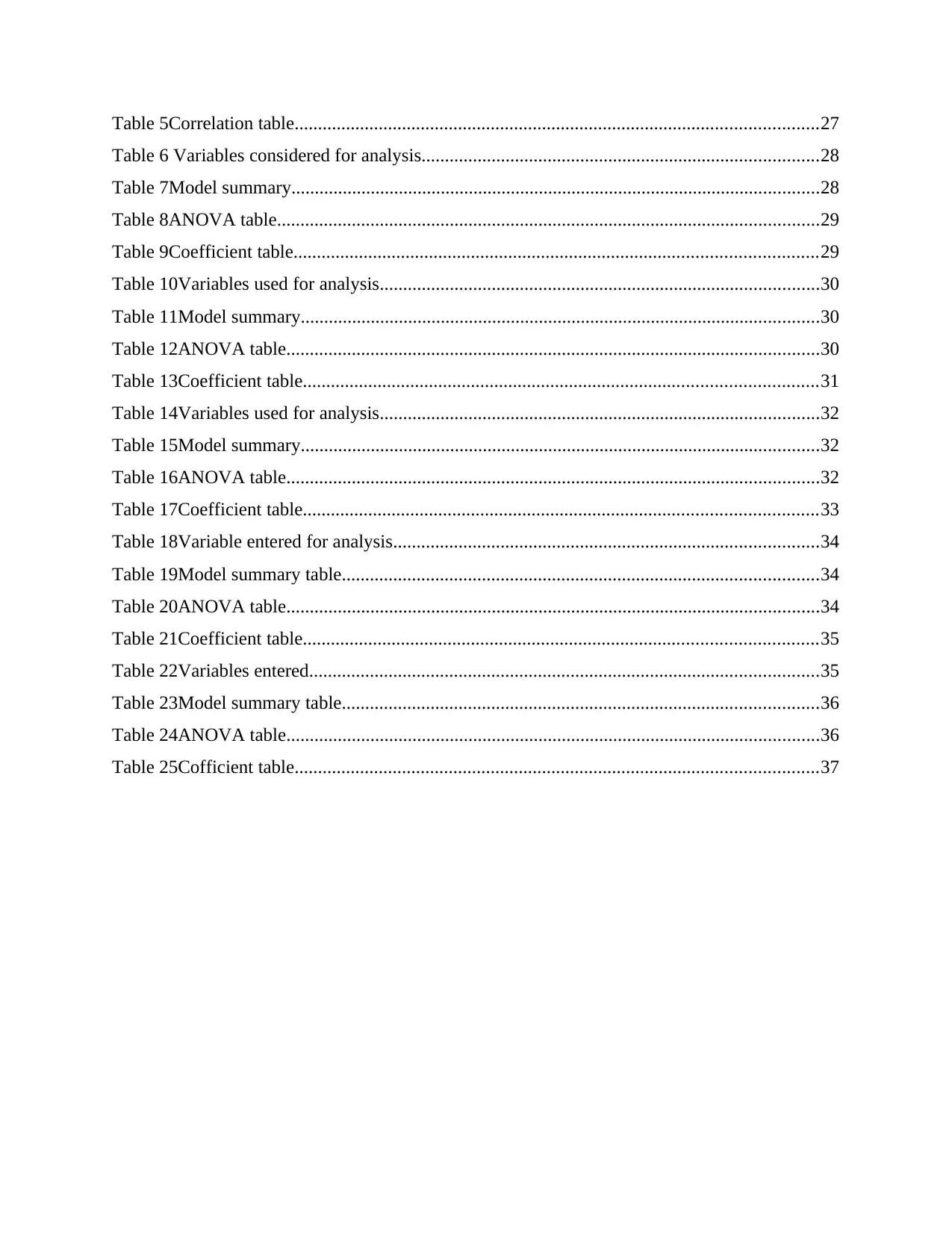
Table 5Correlation table................................................................................................................27
Table 6 Variables considered for analysis.....................................................................................28
Table 7Model summary.................................................................................................................28
Table 8ANOVA table....................................................................................................................29
Table 9Coefficient table................................................................................................................29
Table 10Variables used for analysis..............................................................................................30
Table 11Model summary...............................................................................................................30
Table 12ANOVA table..................................................................................................................30
Table 13Coefficient table..............................................................................................................31
Table 14Variables used for analysis..............................................................................................32
Table 15Model summary...............................................................................................................32
Table 16ANOVA table..................................................................................................................32
Table 17Coefficient table..............................................................................................................33
Table 18Variable entered for analysis...........................................................................................34
Table 19Model summary table......................................................................................................34
Table 20ANOVA table..................................................................................................................34
Table 21Coefficient table..............................................................................................................35
Table 22Variables entered.............................................................................................................35
Table 23Model summary table......................................................................................................36
Table 24ANOVA table..................................................................................................................36
Table 25Cofficient table................................................................................................................37
Table 6 Variables considered for analysis.....................................................................................28
Table 7Model summary.................................................................................................................28
Table 8ANOVA table....................................................................................................................29
Table 9Coefficient table................................................................................................................29
Table 10Variables used for analysis..............................................................................................30
Table 11Model summary...............................................................................................................30
Table 12ANOVA table..................................................................................................................30
Table 13Coefficient table..............................................................................................................31
Table 14Variables used for analysis..............................................................................................32
Table 15Model summary...............................................................................................................32
Table 16ANOVA table..................................................................................................................32
Table 17Coefficient table..............................................................................................................33
Table 18Variable entered for analysis...........................................................................................34
Table 19Model summary table......................................................................................................34
Table 20ANOVA table..................................................................................................................34
Table 21Coefficient table..............................................................................................................35
Table 22Variables entered.............................................................................................................35
Table 23Model summary table......................................................................................................36
Table 24ANOVA table..................................................................................................................36
Table 25Cofficient table................................................................................................................37
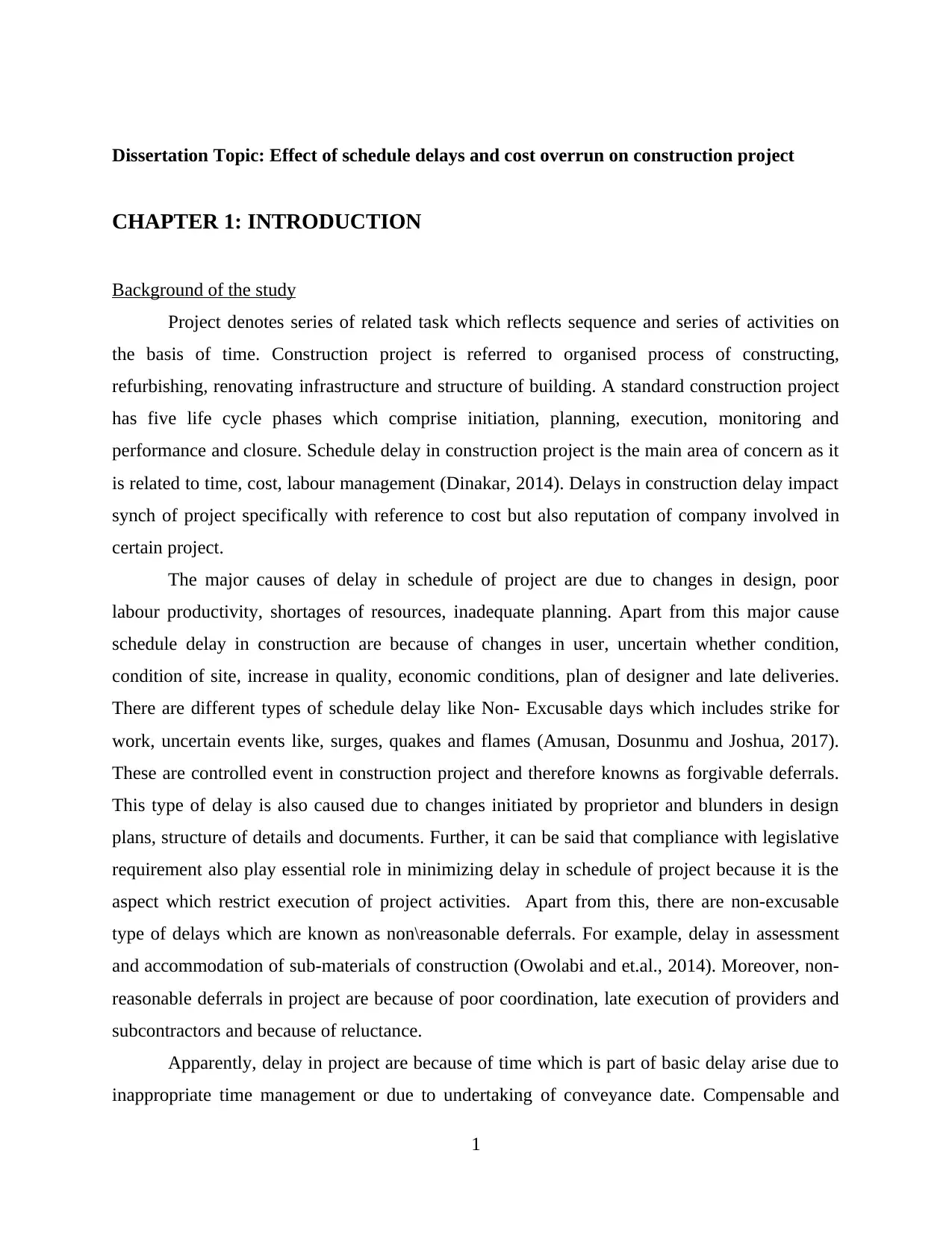
Dissertation Topic: Effect of schedule delays and cost overrun on construction project
CHAPTER 1: INTRODUCTION
Background of the study
Project denotes series of related task which reflects sequence and series of activities on
the basis of time. Construction project is referred to organised process of constructing,
refurbishing, renovating infrastructure and structure of building. A standard construction project
has five life cycle phases which comprise initiation, planning, execution, monitoring and
performance and closure. Schedule delay in construction project is the main area of concern as it
is related to time, cost, labour management (Dinakar, 2014). Delays in construction delay impact
synch of project specifically with reference to cost but also reputation of company involved in
certain project.
The major causes of delay in schedule of project are due to changes in design, poor
labour productivity, shortages of resources, inadequate planning. Apart from this major cause
schedule delay in construction are because of changes in user, uncertain whether condition,
condition of site, increase in quality, economic conditions, plan of designer and late deliveries.
There are different types of schedule delay like Non- Excusable days which includes strike for
work, uncertain events like, surges, quakes and flames (Amusan, Dosunmu and Joshua, 2017).
These are controlled event in construction project and therefore knowns as forgivable deferrals.
This type of delay is also caused due to changes initiated by proprietor and blunders in design
plans, structure of details and documents. Further, it can be said that compliance with legislative
requirement also play essential role in minimizing delay in schedule of project because it is the
aspect which restrict execution of project activities. Apart from this, there are non-excusable
type of delays which are known as non\reasonable deferrals. For example, delay in assessment
and accommodation of sub-materials of construction (Owolabi and et.al., 2014). Moreover, non-
reasonable deferrals in project are because of poor coordination, late execution of providers and
subcontractors and because of reluctance.
Apparently, delay in project are because of time which is part of basic delay arise due to
inappropriate time management or due to undertaking of conveyance date. Compensable and
1
CHAPTER 1: INTRODUCTION
Background of the study
Project denotes series of related task which reflects sequence and series of activities on
the basis of time. Construction project is referred to organised process of constructing,
refurbishing, renovating infrastructure and structure of building. A standard construction project
has five life cycle phases which comprise initiation, planning, execution, monitoring and
performance and closure. Schedule delay in construction project is the main area of concern as it
is related to time, cost, labour management (Dinakar, 2014). Delays in construction delay impact
synch of project specifically with reference to cost but also reputation of company involved in
certain project.
The major causes of delay in schedule of project are due to changes in design, poor
labour productivity, shortages of resources, inadequate planning. Apart from this major cause
schedule delay in construction are because of changes in user, uncertain whether condition,
condition of site, increase in quality, economic conditions, plan of designer and late deliveries.
There are different types of schedule delay like Non- Excusable days which includes strike for
work, uncertain events like, surges, quakes and flames (Amusan, Dosunmu and Joshua, 2017).
These are controlled event in construction project and therefore knowns as forgivable deferrals.
This type of delay is also caused due to changes initiated by proprietor and blunders in design
plans, structure of details and documents. Further, it can be said that compliance with legislative
requirement also play essential role in minimizing delay in schedule of project because it is the
aspect which restrict execution of project activities. Apart from this, there are non-excusable
type of delays which are known as non\reasonable deferrals. For example, delay in assessment
and accommodation of sub-materials of construction (Owolabi and et.al., 2014). Moreover, non-
reasonable deferrals in project are because of poor coordination, late execution of providers and
subcontractors and because of reluctance.
Apparently, delay in project are because of time which is part of basic delay arise due to
inappropriate time management or due to undertaking of conveyance date. Compensable and
1
⊘ This is a preview!⊘
Do you want full access?
Subscribe today to unlock all pages.

Trusted by 1+ million students worldwide
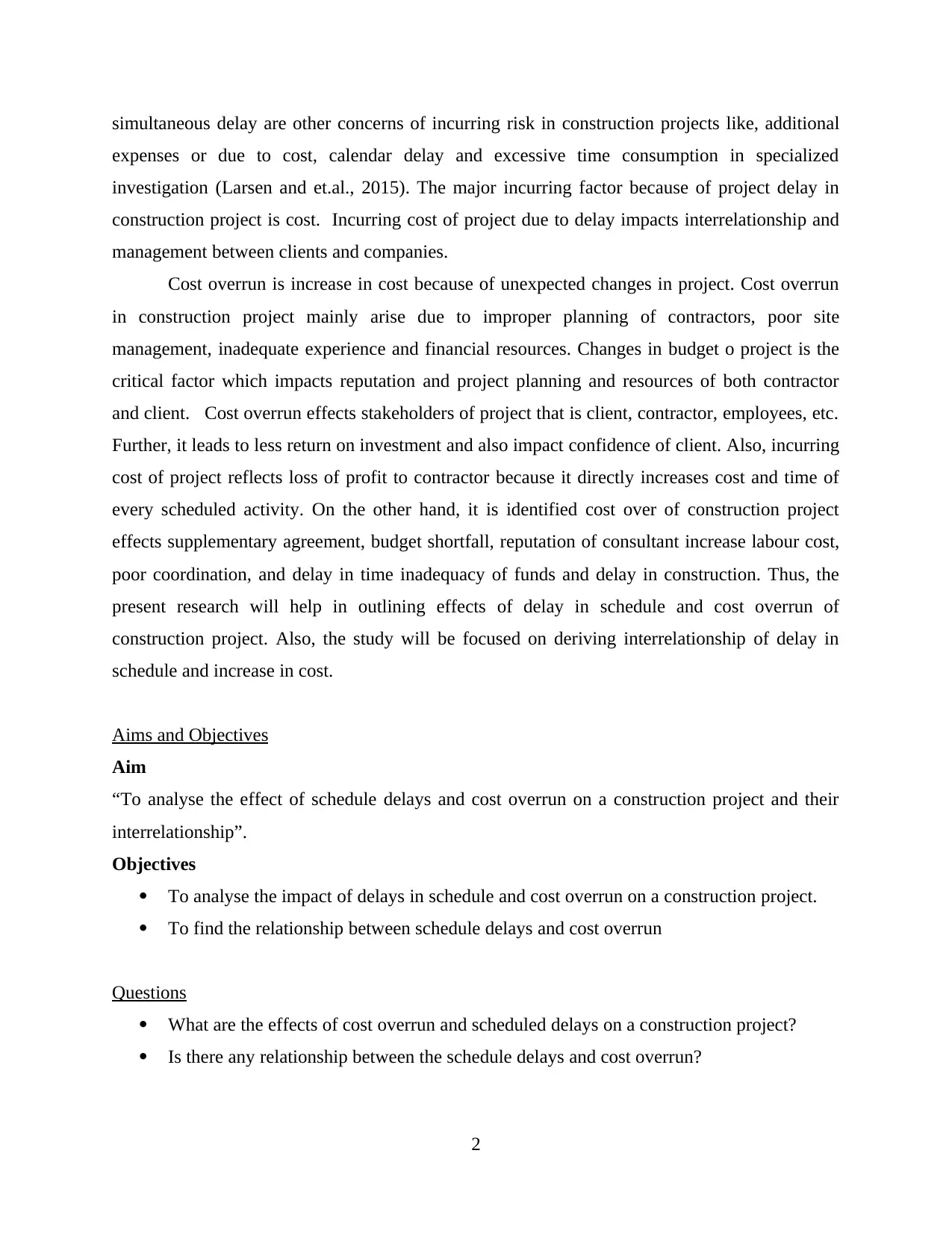
simultaneous delay are other concerns of incurring risk in construction projects like, additional
expenses or due to cost, calendar delay and excessive time consumption in specialized
investigation (Larsen and et.al., 2015). The major incurring factor because of project delay in
construction project is cost. Incurring cost of project due to delay impacts interrelationship and
management between clients and companies.
Cost overrun is increase in cost because of unexpected changes in project. Cost overrun
in construction project mainly arise due to improper planning of contractors, poor site
management, inadequate experience and financial resources. Changes in budget o project is the
critical factor which impacts reputation and project planning and resources of both contractor
and client. Cost overrun effects stakeholders of project that is client, contractor, employees, etc.
Further, it leads to less return on investment and also impact confidence of client. Also, incurring
cost of project reflects loss of profit to contractor because it directly increases cost and time of
every scheduled activity. On the other hand, it is identified cost over of construction project
effects supplementary agreement, budget shortfall, reputation of consultant increase labour cost,
poor coordination, and delay in time inadequacy of funds and delay in construction. Thus, the
present research will help in outlining effects of delay in schedule and cost overrun of
construction project. Also, the study will be focused on deriving interrelationship of delay in
schedule and increase in cost.
Aims and Objectives
Aim
“To analyse the effect of schedule delays and cost overrun on a construction project and their
interrelationship”.
Objectives
To analyse the impact of delays in schedule and cost overrun on a construction project.
To find the relationship between schedule delays and cost overrun
Questions
What are the effects of cost overrun and scheduled delays on a construction project?
Is there any relationship between the schedule delays and cost overrun?
2
expenses or due to cost, calendar delay and excessive time consumption in specialized
investigation (Larsen and et.al., 2015). The major incurring factor because of project delay in
construction project is cost. Incurring cost of project due to delay impacts interrelationship and
management between clients and companies.
Cost overrun is increase in cost because of unexpected changes in project. Cost overrun
in construction project mainly arise due to improper planning of contractors, poor site
management, inadequate experience and financial resources. Changes in budget o project is the
critical factor which impacts reputation and project planning and resources of both contractor
and client. Cost overrun effects stakeholders of project that is client, contractor, employees, etc.
Further, it leads to less return on investment and also impact confidence of client. Also, incurring
cost of project reflects loss of profit to contractor because it directly increases cost and time of
every scheduled activity. On the other hand, it is identified cost over of construction project
effects supplementary agreement, budget shortfall, reputation of consultant increase labour cost,
poor coordination, and delay in time inadequacy of funds and delay in construction. Thus, the
present research will help in outlining effects of delay in schedule and cost overrun of
construction project. Also, the study will be focused on deriving interrelationship of delay in
schedule and increase in cost.
Aims and Objectives
Aim
“To analyse the effect of schedule delays and cost overrun on a construction project and their
interrelationship”.
Objectives
To analyse the impact of delays in schedule and cost overrun on a construction project.
To find the relationship between schedule delays and cost overrun
Questions
What are the effects of cost overrun and scheduled delays on a construction project?
Is there any relationship between the schedule delays and cost overrun?
2
Paraphrase This Document
Need a fresh take? Get an instant paraphrase of this document with our AI Paraphraser
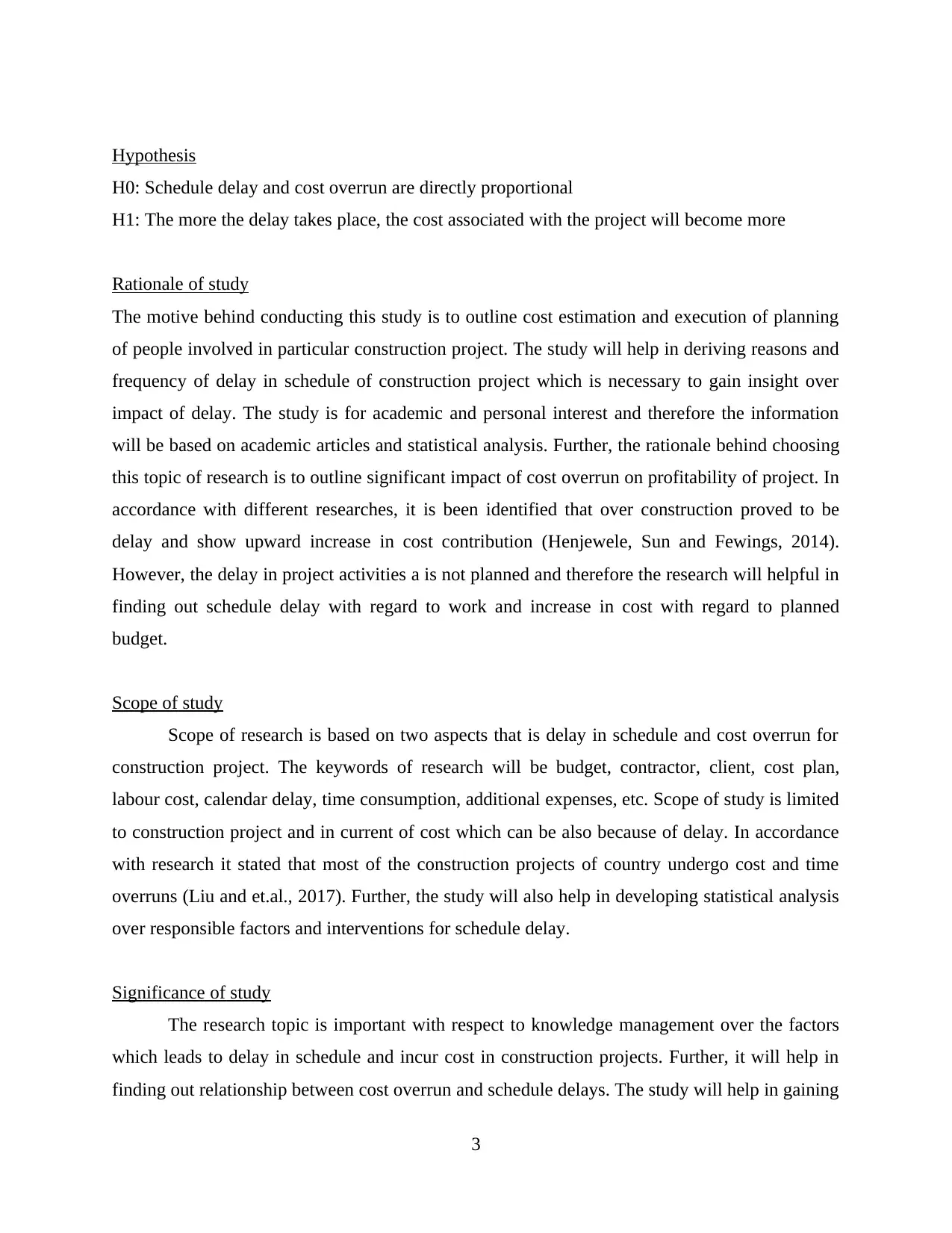
Hypothesis
H0: Schedule delay and cost overrun are directly proportional
H1: The more the delay takes place, the cost associated with the project will become more
Rationale of study
The motive behind conducting this study is to outline cost estimation and execution of planning
of people involved in particular construction project. The study will help in deriving reasons and
frequency of delay in schedule of construction project which is necessary to gain insight over
impact of delay. The study is for academic and personal interest and therefore the information
will be based on academic articles and statistical analysis. Further, the rationale behind choosing
this topic of research is to outline significant impact of cost overrun on profitability of project. In
accordance with different researches, it is been identified that over construction proved to be
delay and show upward increase in cost contribution (Henjewele, Sun and Fewings, 2014).
However, the delay in project activities a is not planned and therefore the research will helpful in
finding out schedule delay with regard to work and increase in cost with regard to planned
budget.
Scope of study
Scope of research is based on two aspects that is delay in schedule and cost overrun for
construction project. The keywords of research will be budget, contractor, client, cost plan,
labour cost, calendar delay, time consumption, additional expenses, etc. Scope of study is limited
to construction project and in current of cost which can be also because of delay. In accordance
with research it stated that most of the construction projects of country undergo cost and time
overruns (Liu and et.al., 2017). Further, the study will also help in developing statistical analysis
over responsible factors and interventions for schedule delay.
Significance of study
The research topic is important with respect to knowledge management over the factors
which leads to delay in schedule and incur cost in construction projects. Further, it will help in
finding out relationship between cost overrun and schedule delays. The study will help in gaining
3
H0: Schedule delay and cost overrun are directly proportional
H1: The more the delay takes place, the cost associated with the project will become more
Rationale of study
The motive behind conducting this study is to outline cost estimation and execution of planning
of people involved in particular construction project. The study will help in deriving reasons and
frequency of delay in schedule of construction project which is necessary to gain insight over
impact of delay. The study is for academic and personal interest and therefore the information
will be based on academic articles and statistical analysis. Further, the rationale behind choosing
this topic of research is to outline significant impact of cost overrun on profitability of project. In
accordance with different researches, it is been identified that over construction proved to be
delay and show upward increase in cost contribution (Henjewele, Sun and Fewings, 2014).
However, the delay in project activities a is not planned and therefore the research will helpful in
finding out schedule delay with regard to work and increase in cost with regard to planned
budget.
Scope of study
Scope of research is based on two aspects that is delay in schedule and cost overrun for
construction project. The keywords of research will be budget, contractor, client, cost plan,
labour cost, calendar delay, time consumption, additional expenses, etc. Scope of study is limited
to construction project and in current of cost which can be also because of delay. In accordance
with research it stated that most of the construction projects of country undergo cost and time
overruns (Liu and et.al., 2017). Further, the study will also help in developing statistical analysis
over responsible factors and interventions for schedule delay.
Significance of study
The research topic is important with respect to knowledge management over the factors
which leads to delay in schedule and incur cost in construction projects. Further, it will help in
finding out relationship between cost overrun and schedule delays. The study will help in gaining
3
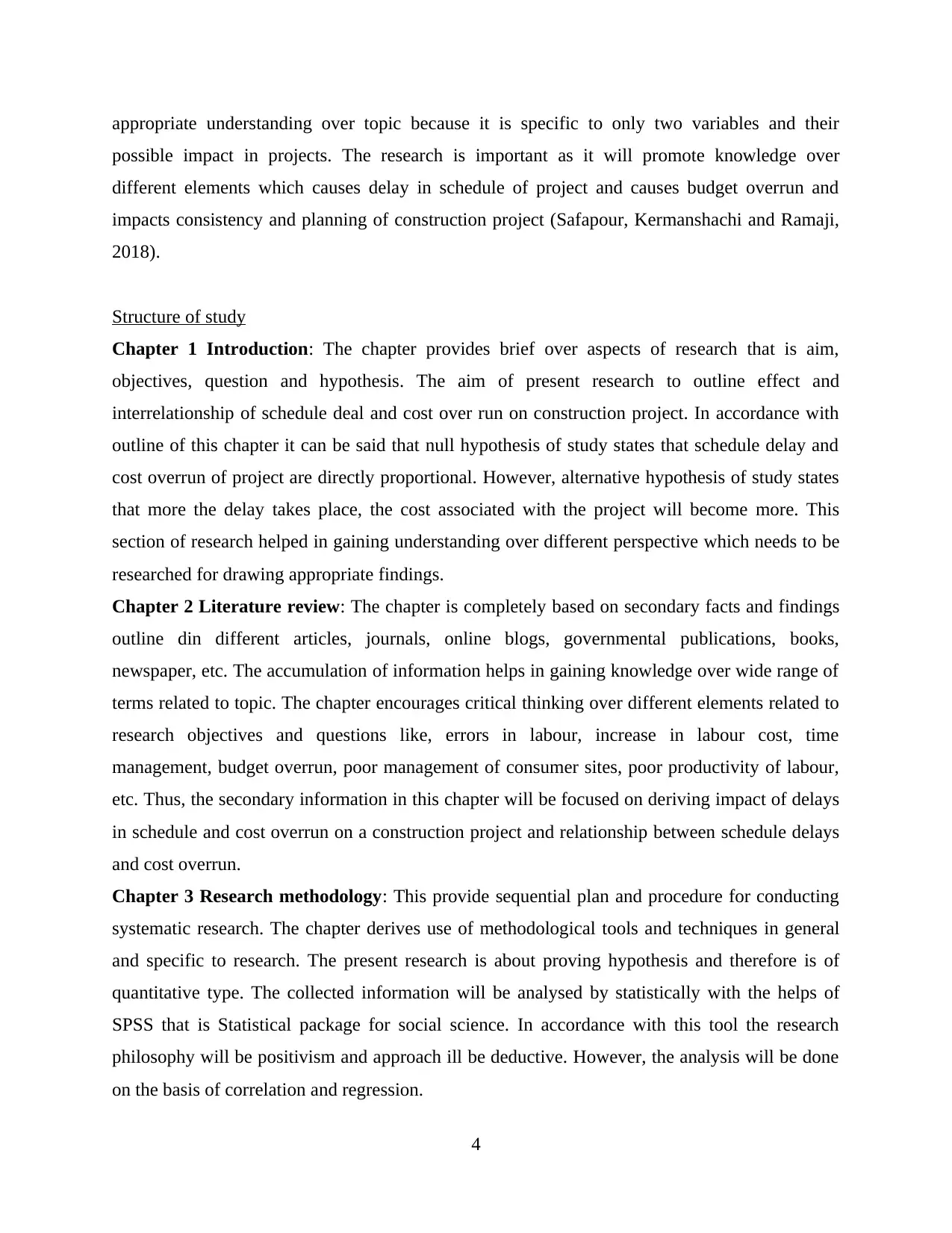
appropriate understanding over topic because it is specific to only two variables and their
possible impact in projects. The research is important as it will promote knowledge over
different elements which causes delay in schedule of project and causes budget overrun and
impacts consistency and planning of construction project (Safapour, Kermanshachi and Ramaji,
2018).
Structure of study
Chapter 1 Introduction: The chapter provides brief over aspects of research that is aim,
objectives, question and hypothesis. The aim of present research to outline effect and
interrelationship of schedule deal and cost over run on construction project. In accordance with
outline of this chapter it can be said that null hypothesis of study states that schedule delay and
cost overrun of project are directly proportional. However, alternative hypothesis of study states
that more the delay takes place, the cost associated with the project will become more. This
section of research helped in gaining understanding over different perspective which needs to be
researched for drawing appropriate findings.
Chapter 2 Literature review: The chapter is completely based on secondary facts and findings
outline din different articles, journals, online blogs, governmental publications, books,
newspaper, etc. The accumulation of information helps in gaining knowledge over wide range of
terms related to topic. The chapter encourages critical thinking over different elements related to
research objectives and questions like, errors in labour, increase in labour cost, time
management, budget overrun, poor management of consumer sites, poor productivity of labour,
etc. Thus, the secondary information in this chapter will be focused on deriving impact of delays
in schedule and cost overrun on a construction project and relationship between schedule delays
and cost overrun.
Chapter 3 Research methodology: This provide sequential plan and procedure for conducting
systematic research. The chapter derives use of methodological tools and techniques in general
and specific to research. The present research is about proving hypothesis and therefore is of
quantitative type. The collected information will be analysed by statistically with the helps of
SPSS that is Statistical package for social science. In accordance with this tool the research
philosophy will be positivism and approach ill be deductive. However, the analysis will be done
on the basis of correlation and regression.
4
possible impact in projects. The research is important as it will promote knowledge over
different elements which causes delay in schedule of project and causes budget overrun and
impacts consistency and planning of construction project (Safapour, Kermanshachi and Ramaji,
2018).
Structure of study
Chapter 1 Introduction: The chapter provides brief over aspects of research that is aim,
objectives, question and hypothesis. The aim of present research to outline effect and
interrelationship of schedule deal and cost over run on construction project. In accordance with
outline of this chapter it can be said that null hypothesis of study states that schedule delay and
cost overrun of project are directly proportional. However, alternative hypothesis of study states
that more the delay takes place, the cost associated with the project will become more. This
section of research helped in gaining understanding over different perspective which needs to be
researched for drawing appropriate findings.
Chapter 2 Literature review: The chapter is completely based on secondary facts and findings
outline din different articles, journals, online blogs, governmental publications, books,
newspaper, etc. The accumulation of information helps in gaining knowledge over wide range of
terms related to topic. The chapter encourages critical thinking over different elements related to
research objectives and questions like, errors in labour, increase in labour cost, time
management, budget overrun, poor management of consumer sites, poor productivity of labour,
etc. Thus, the secondary information in this chapter will be focused on deriving impact of delays
in schedule and cost overrun on a construction project and relationship between schedule delays
and cost overrun.
Chapter 3 Research methodology: This provide sequential plan and procedure for conducting
systematic research. The chapter derives use of methodological tools and techniques in general
and specific to research. The present research is about proving hypothesis and therefore is of
quantitative type. The collected information will be analysed by statistically with the helps of
SPSS that is Statistical package for social science. In accordance with this tool the research
philosophy will be positivism and approach ill be deductive. However, the analysis will be done
on the basis of correlation and regression.
4
⊘ This is a preview!⊘
Do you want full access?
Subscribe today to unlock all pages.

Trusted by 1+ million students worldwide
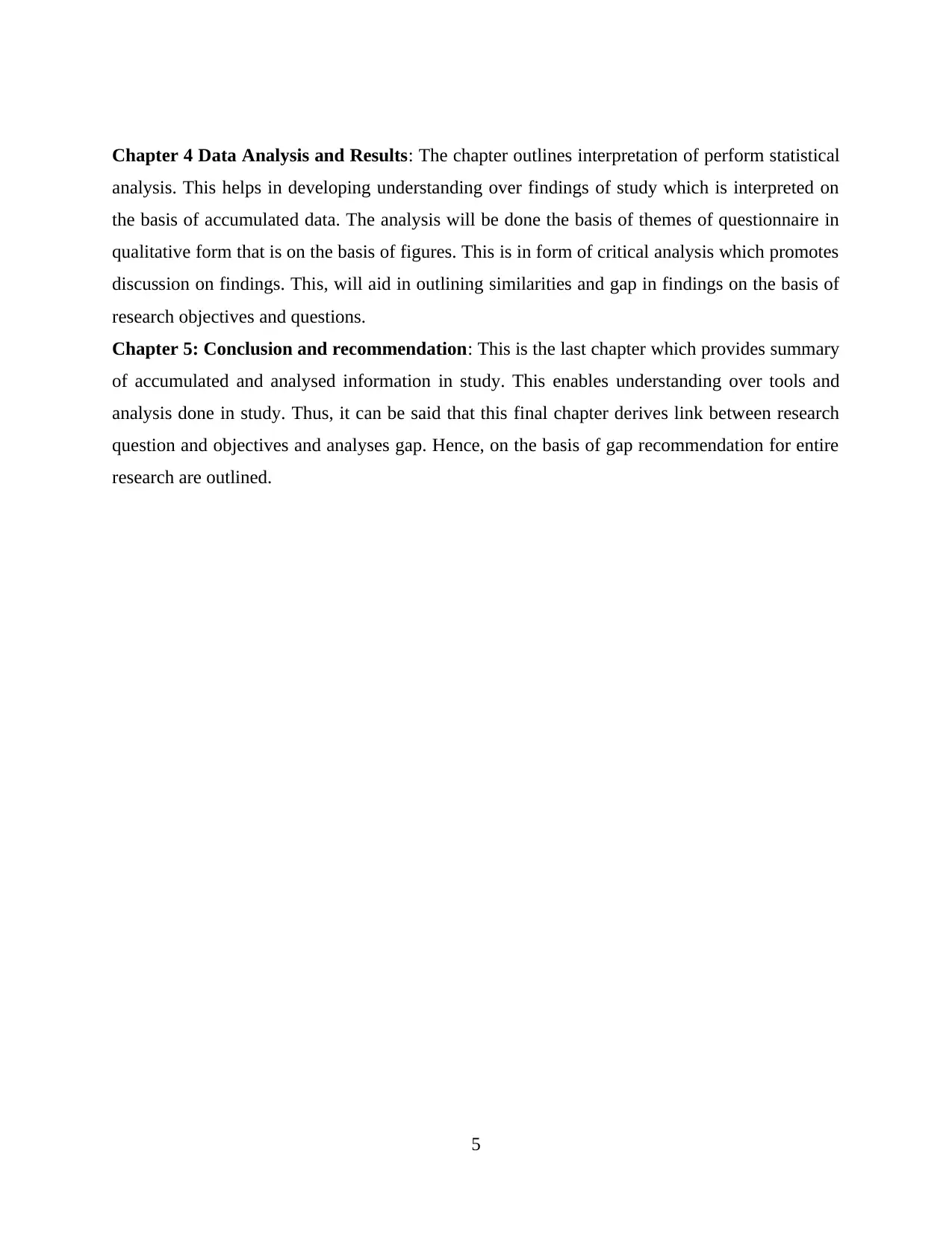
Chapter 4 Data Analysis and Results: The chapter outlines interpretation of perform statistical
analysis. This helps in developing understanding over findings of study which is interpreted on
the basis of accumulated data. The analysis will be done the basis of themes of questionnaire in
qualitative form that is on the basis of figures. This is in form of critical analysis which promotes
discussion on findings. This, will aid in outlining similarities and gap in findings on the basis of
research objectives and questions.
Chapter 5: Conclusion and recommendation: This is the last chapter which provides summary
of accumulated and analysed information in study. This enables understanding over tools and
analysis done in study. Thus, it can be said that this final chapter derives link between research
question and objectives and analyses gap. Hence, on the basis of gap recommendation for entire
research are outlined.
5
analysis. This helps in developing understanding over findings of study which is interpreted on
the basis of accumulated data. The analysis will be done the basis of themes of questionnaire in
qualitative form that is on the basis of figures. This is in form of critical analysis which promotes
discussion on findings. This, will aid in outlining similarities and gap in findings on the basis of
research objectives and questions.
Chapter 5: Conclusion and recommendation: This is the last chapter which provides summary
of accumulated and analysed information in study. This enables understanding over tools and
analysis done in study. Thus, it can be said that this final chapter derives link between research
question and objectives and analyses gap. Hence, on the basis of gap recommendation for entire
research are outlined.
5
Paraphrase This Document
Need a fresh take? Get an instant paraphrase of this document with our AI Paraphraser
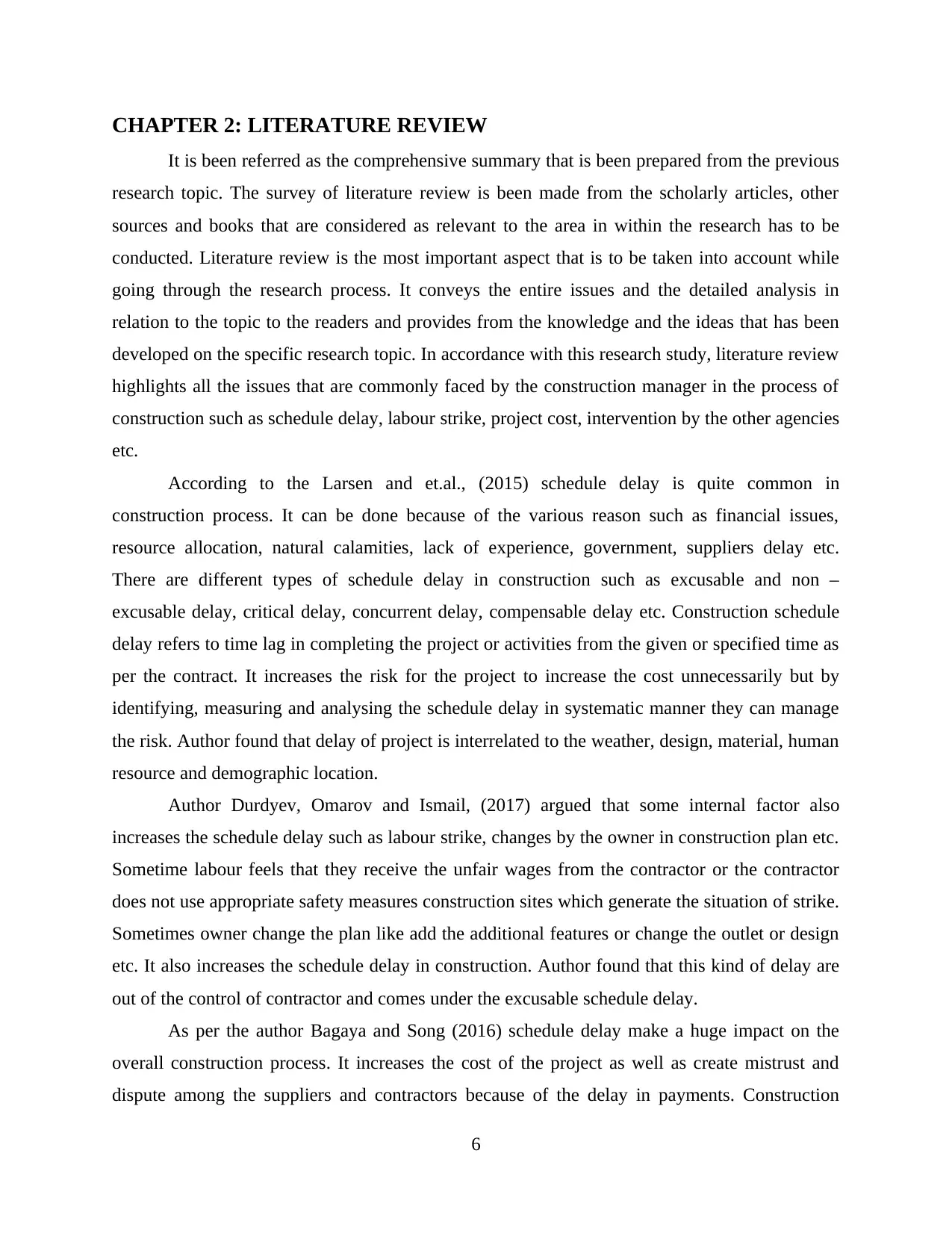
CHAPTER 2: LITERATURE REVIEW
It is been referred as the comprehensive summary that is been prepared from the previous
research topic. The survey of literature review is been made from the scholarly articles, other
sources and books that are considered as relevant to the area in within the research has to be
conducted. Literature review is the most important aspect that is to be taken into account while
going through the research process. It conveys the entire issues and the detailed analysis in
relation to the topic to the readers and provides from the knowledge and the ideas that has been
developed on the specific research topic. In accordance with this research study, literature review
highlights all the issues that are commonly faced by the construction manager in the process of
construction such as schedule delay, labour strike, project cost, intervention by the other agencies
etc.
According to the Larsen and et.al., (2015) schedule delay is quite common in
construction process. It can be done because of the various reason such as financial issues,
resource allocation, natural calamities, lack of experience, government, suppliers delay etc.
There are different types of schedule delay in construction such as excusable and non –
excusable delay, critical delay, concurrent delay, compensable delay etc. Construction schedule
delay refers to time lag in completing the project or activities from the given or specified time as
per the contract. It increases the risk for the project to increase the cost unnecessarily but by
identifying, measuring and analysing the schedule delay in systematic manner they can manage
the risk. Author found that delay of project is interrelated to the weather, design, material, human
resource and demographic location.
Author Durdyev, Omarov and Ismail, (2017) argued that some internal factor also
increases the schedule delay such as labour strike, changes by the owner in construction plan etc.
Sometime labour feels that they receive the unfair wages from the contractor or the contractor
does not use appropriate safety measures construction sites which generate the situation of strike.
Sometimes owner change the plan like add the additional features or change the outlet or design
etc. It also increases the schedule delay in construction. Author found that this kind of delay are
out of the control of contractor and comes under the excusable schedule delay.
As per the author Bagaya and Song (2016) schedule delay make a huge impact on the
overall construction process. It increases the cost of the project as well as create mistrust and
dispute among the suppliers and contractors because of the delay in payments. Construction
6
It is been referred as the comprehensive summary that is been prepared from the previous
research topic. The survey of literature review is been made from the scholarly articles, other
sources and books that are considered as relevant to the area in within the research has to be
conducted. Literature review is the most important aspect that is to be taken into account while
going through the research process. It conveys the entire issues and the detailed analysis in
relation to the topic to the readers and provides from the knowledge and the ideas that has been
developed on the specific research topic. In accordance with this research study, literature review
highlights all the issues that are commonly faced by the construction manager in the process of
construction such as schedule delay, labour strike, project cost, intervention by the other agencies
etc.
According to the Larsen and et.al., (2015) schedule delay is quite common in
construction process. It can be done because of the various reason such as financial issues,
resource allocation, natural calamities, lack of experience, government, suppliers delay etc.
There are different types of schedule delay in construction such as excusable and non –
excusable delay, critical delay, concurrent delay, compensable delay etc. Construction schedule
delay refers to time lag in completing the project or activities from the given or specified time as
per the contract. It increases the risk for the project to increase the cost unnecessarily but by
identifying, measuring and analysing the schedule delay in systematic manner they can manage
the risk. Author found that delay of project is interrelated to the weather, design, material, human
resource and demographic location.
Author Durdyev, Omarov and Ismail, (2017) argued that some internal factor also
increases the schedule delay such as labour strike, changes by the owner in construction plan etc.
Sometime labour feels that they receive the unfair wages from the contractor or the contractor
does not use appropriate safety measures construction sites which generate the situation of strike.
Sometimes owner change the plan like add the additional features or change the outlet or design
etc. It also increases the schedule delay in construction. Author found that this kind of delay are
out of the control of contractor and comes under the excusable schedule delay.
As per the author Bagaya and Song (2016) schedule delay make a huge impact on the
overall construction process. It increases the cost of the project as well as create mistrust and
dispute among the suppliers and contractors because of the delay in payments. Construction
6
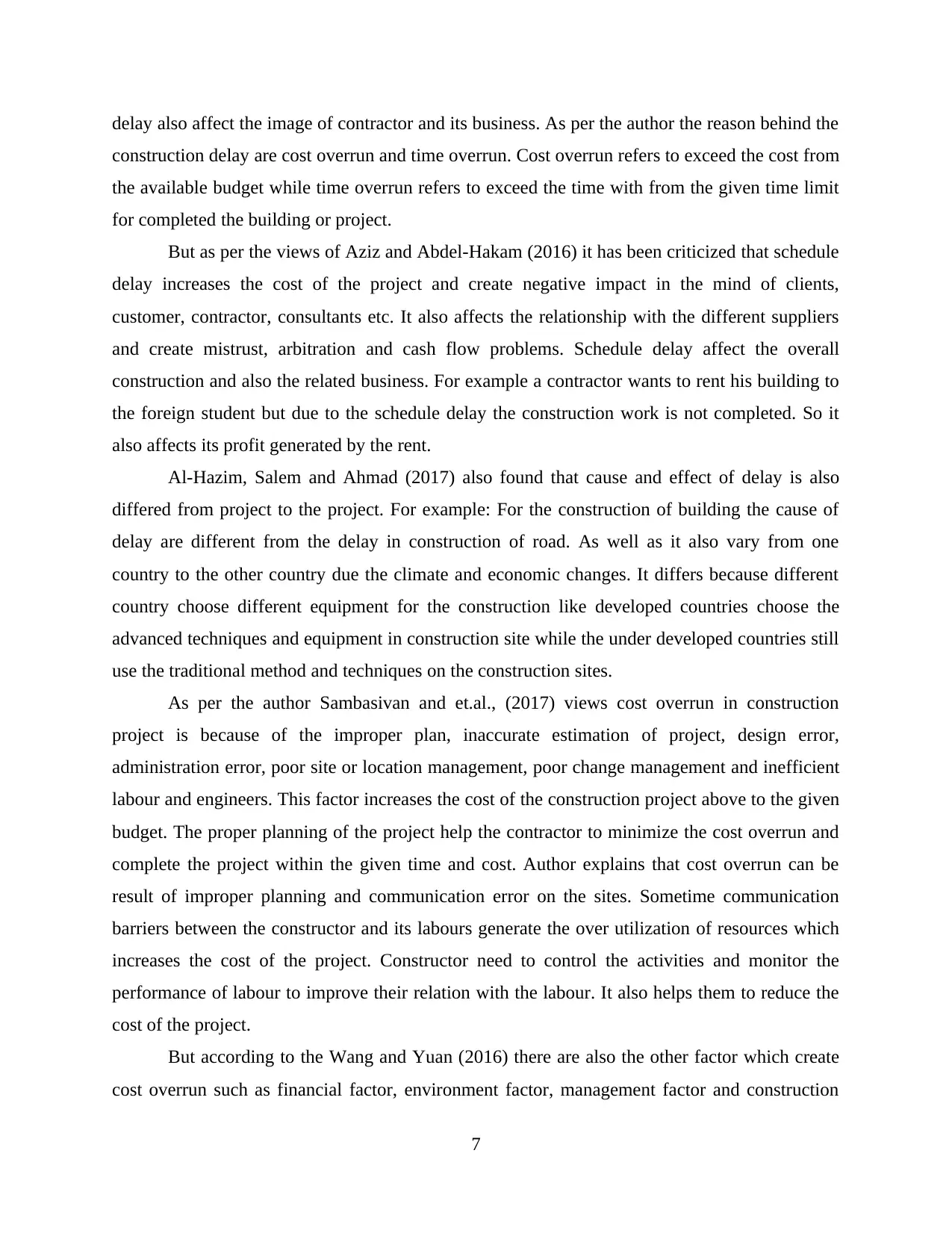
delay also affect the image of contractor and its business. As per the author the reason behind the
construction delay are cost overrun and time overrun. Cost overrun refers to exceed the cost from
the available budget while time overrun refers to exceed the time with from the given time limit
for completed the building or project.
But as per the views of Aziz and Abdel-Hakam (2016) it has been criticized that schedule
delay increases the cost of the project and create negative impact in the mind of clients,
customer, contractor, consultants etc. It also affects the relationship with the different suppliers
and create mistrust, arbitration and cash flow problems. Schedule delay affect the overall
construction and also the related business. For example a contractor wants to rent his building to
the foreign student but due to the schedule delay the construction work is not completed. So it
also affects its profit generated by the rent.
Al-Hazim, Salem and Ahmad (2017) also found that cause and effect of delay is also
differed from project to the project. For example: For the construction of building the cause of
delay are different from the delay in construction of road. As well as it also vary from one
country to the other country due the climate and economic changes. It differs because different
country choose different equipment for the construction like developed countries choose the
advanced techniques and equipment in construction site while the under developed countries still
use the traditional method and techniques on the construction sites.
As per the author Sambasivan and et.al., (2017) views cost overrun in construction
project is because of the improper plan, inaccurate estimation of project, design error,
administration error, poor site or location management, poor change management and inefficient
labour and engineers. This factor increases the cost of the construction project above to the given
budget. The proper planning of the project help the contractor to minimize the cost overrun and
complete the project within the given time and cost. Author explains that cost overrun can be
result of improper planning and communication error on the sites. Sometime communication
barriers between the constructor and its labours generate the over utilization of resources which
increases the cost of the project. Constructor need to control the activities and monitor the
performance of labour to improve their relation with the labour. It also helps them to reduce the
cost of the project.
But according to the Wang and Yuan (2016) there are also the other factor which create
cost overrun such as financial factor, environment factor, management factor and construction
7
construction delay are cost overrun and time overrun. Cost overrun refers to exceed the cost from
the available budget while time overrun refers to exceed the time with from the given time limit
for completed the building or project.
But as per the views of Aziz and Abdel-Hakam (2016) it has been criticized that schedule
delay increases the cost of the project and create negative impact in the mind of clients,
customer, contractor, consultants etc. It also affects the relationship with the different suppliers
and create mistrust, arbitration and cash flow problems. Schedule delay affect the overall
construction and also the related business. For example a contractor wants to rent his building to
the foreign student but due to the schedule delay the construction work is not completed. So it
also affects its profit generated by the rent.
Al-Hazim, Salem and Ahmad (2017) also found that cause and effect of delay is also
differed from project to the project. For example: For the construction of building the cause of
delay are different from the delay in construction of road. As well as it also vary from one
country to the other country due the climate and economic changes. It differs because different
country choose different equipment for the construction like developed countries choose the
advanced techniques and equipment in construction site while the under developed countries still
use the traditional method and techniques on the construction sites.
As per the author Sambasivan and et.al., (2017) views cost overrun in construction
project is because of the improper plan, inaccurate estimation of project, design error,
administration error, poor site or location management, poor change management and inefficient
labour and engineers. This factor increases the cost of the construction project above to the given
budget. The proper planning of the project help the contractor to minimize the cost overrun and
complete the project within the given time and cost. Author explains that cost overrun can be
result of improper planning and communication error on the sites. Sometime communication
barriers between the constructor and its labours generate the over utilization of resources which
increases the cost of the project. Constructor need to control the activities and monitor the
performance of labour to improve their relation with the labour. It also helps them to reduce the
cost of the project.
But according to the Wang and Yuan (2016) there are also the other factor which create
cost overrun such as financial factor, environment factor, management factor and construction
7
⊘ This is a preview!⊘
Do you want full access?
Subscribe today to unlock all pages.

Trusted by 1+ million students worldwide
1 out of 60
Related Documents
Your All-in-One AI-Powered Toolkit for Academic Success.
+13062052269
info@desklib.com
Available 24*7 on WhatsApp / Email
![[object Object]](/_next/static/media/star-bottom.7253800d.svg)
Unlock your academic potential
Copyright © 2020–2025 A2Z Services. All Rights Reserved. Developed and managed by ZUCOL.





